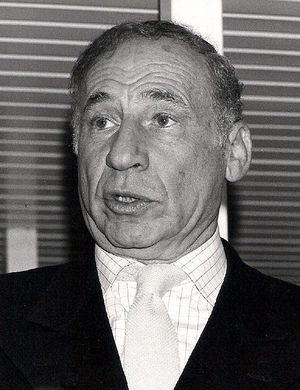Mel Brooks’ film Young Frankenstein parodies numerous Frankenstein films such as; Frankenstein (1931), The Bride of Frankenstein (1935), The Son of Frankenstein (1939), and The Ghost of Frankenstein (1942). Through the use of parody, Brooks is able to comment on these films while staying within the limits of the genre. The film also adds other elements of Jewish humor such as show business, the “outsider,” and the shiksa. As Blazing Saddles noted the historical inaccuracies of racism for western movies, Young Frankenstein observes the differences in sexual ideology the 1970s had opposed to the views of the 1930s and 40s. Earlier Frankenstein pictures implicitly showed the monster as a sexually charged beast and Dr. Frankenstein as a sexually repressed man. By allowing the characters to know they are placed in fiction, Young Frankenstein gives Dr. Frankenstein and the monster the option to alienate from genre stereotypes. This ability to be alienated shows up in Dr. Frankenstein’s choice for sexual freedom and the monster’s choice to fit in.
A major element of parody is self-awareness by the film overall, but more specifically by the characters within the film. David Desser writes that the “characters have a modern consciousness of their roles within the Frankenstein legend and even mug at the camera with sly smiles of understanding” (Desser, 139). The overall self-awareness has to do with the knowledge of the older text and the structures within the particular genre. Maurice Yacowar, in the book Method in Madness: The Comic Art of Mel Brooks, writes that Brooks’ “characters are aware of the Frankenstein legend and its conventions of plot” (Yacowar, 123). One example is when Dr. Frankenstein (Gene Wilder) looks for a secret passageway hoping to find his grandfather’s secret library. Frankenstein says that “there’s always a device”, signifying his knowledge of the horror genre. Self-awareness shows up again when the monster (Peter Boyle) is with the young girl. Yacowar explains that “Having dropped a flower down the well…the little peasant girl innocently asks him, ‘oh dear, what shall we throw in now?’ The monster smiles to his film audience; he knows his part in this legend” (Yacowar, 124). This is, or course, one instance when the monster breaks the genre code and ends up not killing the little girl, but instead sends her safely back to her bedroom. Having established this sense of self-awareness will demonstrate both of these character’s attempts to break with genre stereotypes in regards to sexual desire.
The first character to consider is Dr. Frankenstein who, in all of the 30s and 40s films, represents a man who never shows any sexual desire. In some cases he has a wife, or is planning to be married, but is never actually shown sexually craving those women. Young Frankenstein tweaks that notion, at first, and then totally changes it. Wilder’s (the name fits perfectly) Frankenstein does show sexual longing for his fiancée (Madeline Kahn), only to be continually rejected. This rejection signifies the film’s awareness for the genre. Frankenstein cannot have sexual encounters with this woman because none of his predecessor’s did. Desser shows how Brooks uses this trope to insert particularly Jewish motifs. He writes that Kahn’s character “is incarnated as finicky, self-obsessed, Jewish American princess whose hints of sex represent nothing but perpetual foreplay, much to Dr. Frankenstein’s anguish” (Desser, 142). Frankenstein seems to be stuck in the genre with no hope of escaping, similar to the protagonists in The Producers, who parodied the “putting on a show” musical with hopes of disaster, only to see it succeed (as it always does within the genre).
Dr. Frankenstein does, though, differ from Leo and Max because he ends up experiencing sexual pleasure. This is embodied by another Jewish motif…the shiksa, Inga (Teri Garr). Desser writes that “Garr’s blonde Scandinavian appears as another incarnation of Brooks’s obsession with buxom bimbos, a variation of the sexually alluring shiksa so much a part of American Jewish films and books” (Desser, 142). With her, Frankenstein does have sex (on the ‘life creating’ machine) and establishes some sort of sexual freedom that will be completed later on. So, much like Bart sexualized the un-sexual western hero, Frederick begins to sexualize the mad scientist.
The monster begins at the opposite end of the spectrum from Frankenstein. In the original horror films, the monster represented the über-sexual being. Yacowar writes, “in the horror tradition, the various monsters embody the sexual and physical potential that civilized man dreads unleashed” (Yacowar, 127). As it does with the doctor, Young Frankenstein starts with the monster stuck within the genre’s parameters. A scene that implied rape in the original film is brought to comedic light in this one. The monster kidnaps Dr. Frankenstein’s fiancée and rapes her. Although, during the act, she begins to like it and sings “Oh Sweet Mystery of Life” and continually comments on the monster’s “size.” The monster, thus, liberates Kahn’s character from her frigidness, but still contains his over-sexed stereotype. It is evident that the monster wants to conform to normal sexual behavior, since he tries to conform in every other way. American Jewish Filmmakers says that the monster is “a creature so driven to fit in, to belong, that he dons white tie and tails to join his maker in a duet of ‘Puttin’ on the Ritz’ before the Bucharest Academy of Science” (Desser, 140). His character in relation to the genre would deem him unsuitable for conformity, usually ending up in his “death.” Again, Young Frankenstein allows the character to break free of the stereotype.
This yearning for conformity adds more to the Jewish nature of the film as well. Not only does the creature perform a vaudevillian version of “Puttin’ on the Ritz”, which shows the show-business motif of Jewish filmmaking, but as Desser puts it, Brooks is concerned about “never being good enough or being allowed to join mainstream culture because of being Jewish” (Desser, 140). It is also important to notice that “the question of why society ostracizes the monster becomes much more important than what the monster does to alienate society” (Desser, 140). The monster does not choose to be the way he is, but he was created that way. Much like Jews, the reason they are ostracized is not because of their choices, but because of how they were made. The earlier Frankenstein horror films ended up being too afraid to accept the outsider and continually killed him. It is unmistakable then that “the failure to love, therefore, is not the creature’s but the creator’s” (Desser, 141). But “unlike his fictional counterpart and cinematic precursors, Brooks’s Dr. Frankenstein realizes that ‘love is the only thing that can save this poor creature’ and resolves to risk his life to ‘convince him that he is loved'” (Desser, 141). It is this love that leads to the total transformation out of the genre stereotypes concerning sexual freedom.
The scene that brings both of these sexual opposites together is Dr. Frankenstein’s sacrifice of his life to save the monster’s. After the transplant both characters marry the women that they previously slept with. The monster marries the doctor’s old fiancée and the doctor marries Inga. In his bedroom scene, the monster is “avidly reading the Wall Street Journal at the movie’s conclusion, By using parody Mel Brooks uses similar genre stereotypes and allows his characters to change their predictable outcome. The normally sexually repressed Dr. Frankenstein emerges into a normally functioning sexual male while the monster changes from an over-sexed beast into the same sexual male. Through this transformation, the Jewish motifs inherent throughout Jewish film appear in the forms of show business, the “outsider,” and the shiksa. With all of these tropes functioning, Young Frankenstein differs from Brooks’ other parodies by allowing the characters to succeed in spite of their genre. Sexual growth in this film stands as an alienation from genre stereotypes in a structure that calls for assimilation.



